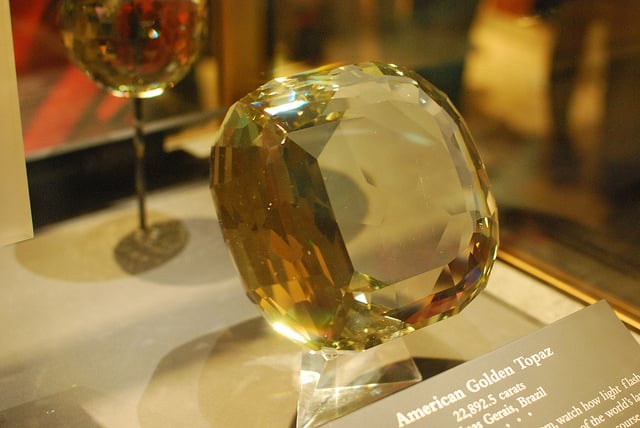Topaz Symbolism
Topaz's most popular mystical association has been with wealth. However, topaz symbolism and lore also covers areas such as health, love, and astrology.
3 Minute Read
Topaz's Golden Touch
Before the 20th century, all yellow, brown, and orange transparent gems were called topazes. Modern gemology has defined topaz as a distinct gem species, chemically and physically. Although topazes come in many colors — such as rare, natural pinks and reds as well as treated blues and coated varieties — many people still associate these gems with yellow.
Most likely due to this yellow color, some believed topaz had the mystical ability to attract gold. In particular, topazes set in gold purportedly did this most adeptly. Apparently, esteem follows wealth, as topaz has been associated with royalty, too.
Interested in this topic?
This article is also a part of our Topaz Specialist Mini Course, in the unit Introduction to Topaz.
In the Middle Ages, carved gemstones were believed to be natural wonders possessing special powers. For example, in the 13th century CE work, The Book of Wings, Ragiel writes:
The figure of a falcon, if on a topaz, helps to acquire the goodwill of kings, princes, and magnates.
Health, Magic, and Topaz Symbolism
If worn on the left arm, some believed a topaz amulet could protect the wearer from dark magic. In addition, this could relieve arthritis pain, improve digestion, aid in weight loss, and attract love. If taken in a potion, some believed it could cure an even wider range of ailments.
St. Hildegard recommended the topaz as a cure for dim vision. After soaking a topaz in wine for three days and nights, rubbing the stone gently on the eyes would help. Perhaps this connection to vision helps explain another popular belief, that topaz could render its wearer invisible.
If kept in the home, some believed a topaz could ward off accidents and fires. If kept under a pillow, it could prevent nightmares.
Astrology and Topaz Symbolism
Hindu traditions associate topaz astrologically with Jupiter. Rings set in astrological sequence as represented by different stones are called the "nine-gem" jewel, Naoratna or Navaratna. Since ancient times, talismans set in the prescribed manner with flawless gemstones were considered very powerful. The gems in this setting are:
- Ruby, in the center, for the Sun.
- Diamond, to the East, for Venus.
- Pearl, to the Southeast, for the Moon.
- Coral, to the South, for Mars.
- Jacinth, to the Southwest, for Rahu (head of the Dragon, the ascending node, indicating the passage of the Moon on the ascent above this plane).
- Sapphire, to the West, for Saturn.
- Topaz, to the Northwest, for Jupiter.
- Cat's eye, to the North, for the descending node (tail of the Dragon, the descent of the Moon).
- Emerald, to the Northeast, for Mercury.
Please note, jacinth now means an orange-red to red-brown zircon. However, ancient descriptions of jacinth's color range from blue to golden.
The placement of the ascent and descent of the Moon into this setting brings "movement" to this arrangement. Hence, this brings power to the talisman. A very interesting way of looking at jewelry settings, indeed!
Was Topaz One of the Stones of the Breastplate of Aaron?
As mentioned earlier, the term topaz traditionally covered many types of yellow, orange, and brown gems. Some ancient references to topaz also indicate a greenish stone. Although topazes can be green, these sources most likely refer to peridot. Until the 19th century, both peridots and yellow-green chrysoberyls were known as chrysolites. To add a little more confusion, chrysolite also means "golden stone." Thus, the chrysolite of the breastplate of Aaron likely refers to peridot.
Confusion over ancient names of stones and their properties has generated much debate over the identity of these gems. As soon as you list a set of names, you've opened a can of worms. Just what stones were actually meant by each name?
Most likely, we will never solve this mystery completely. If you wish to duplicate the breastplate setting, you're better off trying to match the color descriptions of the gems with stones commonly available at that time. Ironically, this is probably what the ancients did, which contributed to the confusion over what they meant and what was the "right" setting.
Fara Braid
International Gem Society
Related Articles
Topaz Value, Price, and Jewelry Information
How Does Topaz Form?
Colorful Options: Choosing Topaz Engagement Ring Stones
Top Spots for Gem Hunting in the US
Latest Articles
Cutting a 294-ct Trilliant Morganite: An Interview with Steve Moriarty
Tourmaline Engagement Ring Stones: the Ultimate Guide
Chabazite Value, Price, and Jewelry Information
Recutting Diamonds and Colored Gemstones
Never Stop Learning
When you join the IGS community, you get trusted diamond & gemstone information when you need it.
Get Gemology Insights
Get started with the International Gem Society’s free guide to gemstone identification. Join our weekly newsletter & get a free copy of the Gem ID Checklist!
